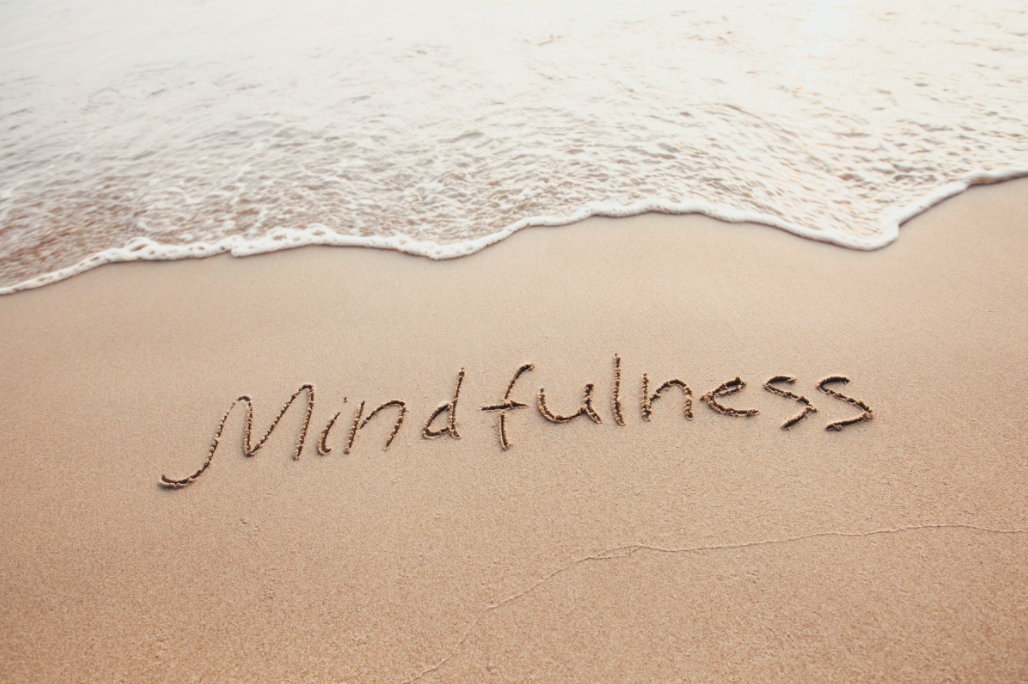By Katherine Sloman, Family First Therapist
You are probably familiar with the word mindfulness. It’s talked about a lot – and for good reason! The benefits of mindfulness are powerful. However, it can feel overwhelming to know where to start. Mindfulness can feel like a huge, intangible thing that some people are able to cultivate and others just naturally aren’t. Luckily, mindfulness is actually something that is inside us all already, and through practice, we can all use mindfulness to make our lives better.
First, what is mindfulness? The definition is simply, “a moment to moment awareness of one’s experience without judgment.” That might sound simple, but it can actually be really hard. Humans have a natural negativity bias. This means we have a tendency not only to register negative stimuli more easily, but also to dwell on these events and to feel critical feedback or comments more intensely than we feel compliments. So, that means that it’s totally natural for the “without judgment” part to be challenging. The good news? It gets easier over time, and mindfulness can help you challenge that negativity bias and stay more present and tuned into the positive.
Mindfulness and the ability to be present without judgment is not something some people have and other people don’t. It’s an innate quality within all of us. You don’t need to buy it, or take a complex course on it; it’s more like a muscle we all have that we have to work and stretch. When you work the mindfulness muscle, you reap many evidence-based benefits (Evidence based simply means that people have been researching it for many years and there are proven benefits we now know to be true). Some of the biggest benefits are stress reduction and a decrease in emotional reactivity. Mindfulness also boosts our working memory, improves our focus and concentration, gives us more insight, and even has relationship benefits through improved communication and reduced reactivity to our partner, friends, and families.
The other great thing about mindfulness is there’s no “right” way to do it. Often, people think of meditating and yes, this is a wonderful way to practice. You can also be mindful through yoga, tai chi, when eating, walking, journaling, through deep breathing or setting intentions; there are so many ways to be mindful and you can pick what works for you. So let’s talk about some of the ways you can practice mindfulness!
Meditation is a powerful thing, but it can have a bad reputation! I hear clients share (and I also have felt these things!) that they can’t do it, they will never get their mind quiet, they’re doing it wrong, and all other kinds of judgments about their ability to quiet down and be still for a little while. It can feel very foreign to sit still and be present in your thoughts. I have what the Buddhists call a “monkey mind,” which means my mind is swinging from branch to branch, from thing to thing, and always moving. If you know what I’m talking about, then you know that this can be tiring! When I meditate, even though sometimes I worry it’s going to make things worse, it always makes me feel better. Sometimes when I meditate I can feel that peaceful experience you might expect, but other times I spend a lot of time just redirecting my racing thoughts back. It’s all still meditation! If you want to try meditating, there are some apps that I love that can help guide you and help you get started:
- Calm: the Calm app is a favorite for many! It’s a subscription model, priced at $70/year. They have guided meditation series that walk you through 10 minutes of meditation as well as guided practices you can choose whenever you want to. They are also very well known for their sleep stories, which are quite literally calming stories read by different actors and authors to help you drift to sleep.
- InsightTimer: This app has both free and subscription options! There are tons of meditation options. Most of the meditations are guided, and you can peruse different categories for your needs whether you want to go to sleep, decrease anxiety, increase confidence, you name it. You also have the option to use their meditation timer by yourself. You can choose the length, if you want background noise, if you want specific tones to ring at intervals. It’s a popular app for a reason!
- Buddhify: This app is less well known but one of my absolute favorites. When you open Buddhify, you see a colored wheel that breaks the guided meditations down into categories. There are meditations for sleep, getting on airplanes, going to work, walking outside, and specific ones for challenging emotions like fear, anger, frustration, sadness, loneliness etc. The meditations range anywhere from 5 to 15 minutes. I’ve been using it for years and I’m still exploring it! It’s a one-time purchase off $5 which gives you access to all their data.
- MindYeti: This app is geared toward children and offers some great free resources. Right now, the app itself is not taking new subscriptions but you can visit their website and find free guided meditations through YouTube, Spotify, and other platforms.
Of course, you don’t need an app to meditate. You can do it without any technology at all. You can just sit still, thinking about your breathing, for 5 minutes or 60 minutes! Some people like to meditate lying down, though I will warn that it’s easy to fall asleep! Another way you can meditate is on a meditative walk. Go outside, start walking, and pay attention to what you notice. Perhaps you notice how the ground feels beneath your feet, the color of the sky, the texture of the leaves, the different smells of the various flowers, the air on your face. You might be surprised how much beauty you find even on walks you take every day when you are practicing noticing without judgment!
Another way to practice mindfulness is through specific exercises. One of my favorites is 5-4-3-2-1. This is a grounding practice! Grounding is similar to mindfulness, but not identical. Grounding is often referenced when doing trauma work, though you can use it anytime you feel out of sorts. Grounding aims to keep you in the present when our minds start to go back into our traumas, or are feeling overwhelmed by a specific emotion or stressor. I like to ground myself after hard meetings or especially stressful days! I love the 5-4-3-2-1 exercise because you can do it anywhere, it’s quick, and very effective. All you need to do is notice. You will notice 5 things you can see, 4 things you feel or can touch, 3 things that you hear, 2 things that you smell, and 1 thing that you taste. For example, say you’re in your living room and looking around the space. You might see a plant and notice the texture of its leaves, you might see the stainless steel on your water glass and how the sun reflects on it, the ceiling fan moving above your head, the pillow on your couch and texture of the velvet, and the coffee maker on the counter. You might feel your arm resting on the couch, the way the throw pillow feels behind your back, the fabric of your shirt on your body, and the watch band on your wrist. You might hear the air purifier’s low rumble, the soft sounds of cars driving by, and your dog’s gentle breathing as he sleeps. You might smell your moisturizer or shampoo, the way your sunscreen smells on your skin. And you might taste coffee from your morning cup you just finished. If you’ve never done this exercise, it can feel a little strange, but trust me, it works!
Mindfulness is flexible, powerful, and anyone can do it. It’s a super power that lives inside of us! Some people just use it more than others. You can practice mindfulness with your children, with your partner, or by yourself. You can do it as a daily routine or pop in and out of it. The most important thing is to not judge yourself and to be gentle as you grow in your own mindfulness journey. Every choice we make to care for ourselves adds up. Mindfulness is a great, and free!, tool to add to your self-care toolbox.
About the Author: Katherine Sloman is a licensed professional counselor and a Family-Based Therapist in the Family First department at Child Guidance Resource Centers. She specializes in supporting families as they develop deeper understanding of their patterns and work to strengthen their relationships. She spends as much of her free time as possible at the beach and is a proud graduate of Northwestern University.

